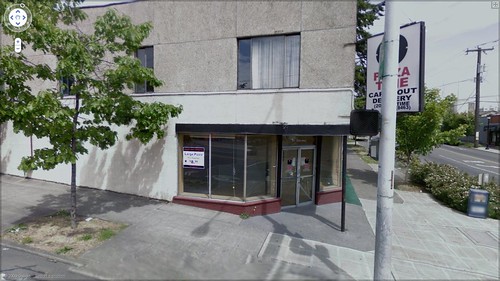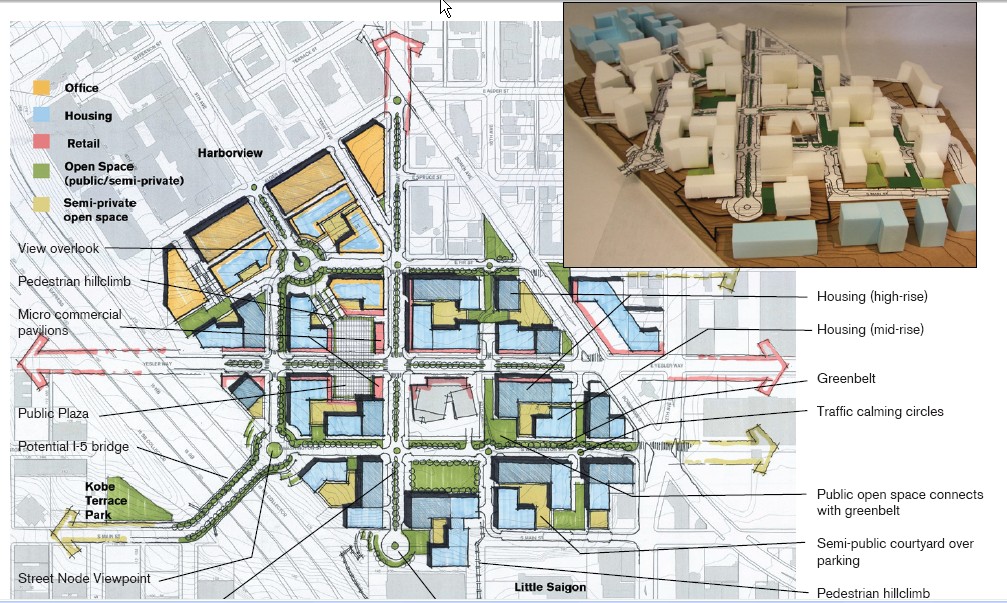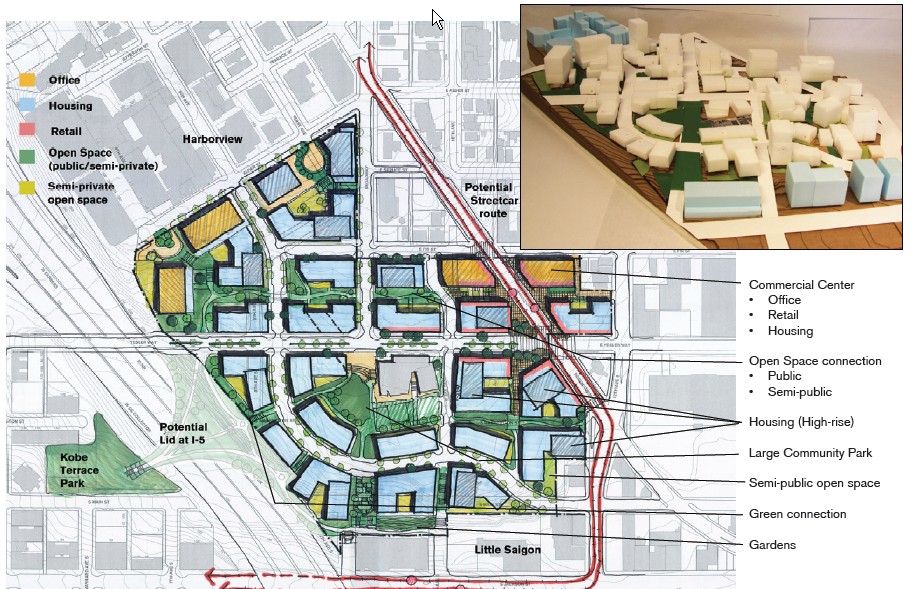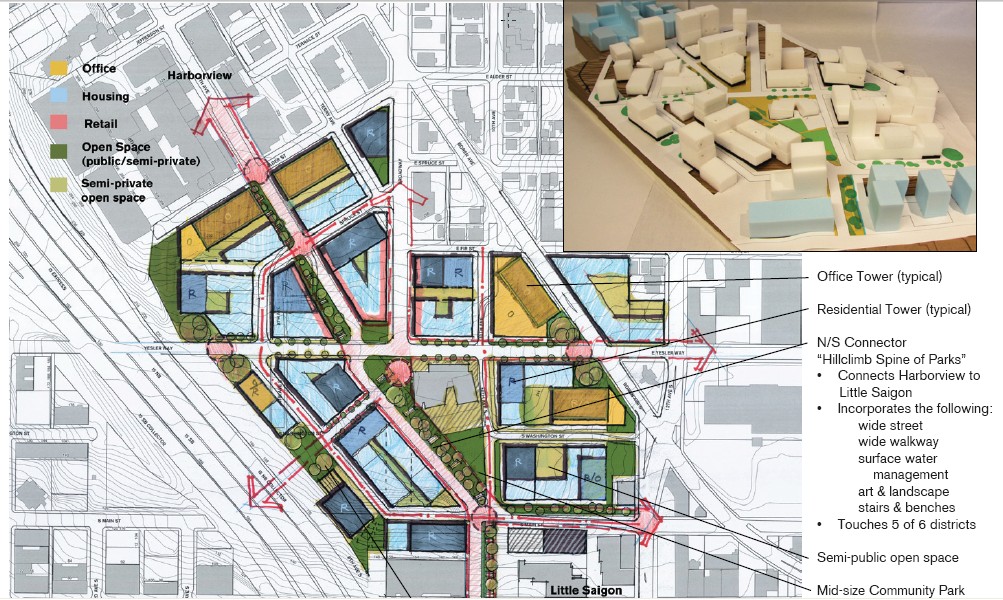
As CD News readers may recall, Yesler Terrace is a 28 acre public housing development situated between First Hill, Little Saigon and the Central District. A couple of years ago, SHA acknowledged that the Yesler Terrace buildings were crumbling and that a redevelopment was warranted. In order to cut down costs and to abide by current urban planning principles, SHA announced that it would partner with private developers and greatly increase the density in Yesler Terrace’s redevelopment. While the new development will continue to provide housing to very low-income people [those making less than 30% of Seattle’s median income ($17,243)], it will also allocate a significant portion in the envisioned 4000 units for market-rate and workforce housing.
In April 2009, the Seattle Housing Authority (SHA) presented three concepts for the redevelopment of Yesler Terrace. Taking a look at the concepts pictured below, you will note that none of the envisioned plans encompass areas east of Boren. Last week, Real Change noted that SHA now plans to develop land it owns along Yesler east of Boren for the Yesler Terrace redevelopment. In fact, SHA may use the old Pizza Time location at 12th Avenue South and Yesler as an initial redevelopment site.
SHA Development Director Stephanie Van Dyke said the agency owns several properties along Yesler Way east of Boren, including an old Pizza Time location at Yesler and Twelth Avenue. The agency may use that site to start building replacements for some of Yesler Terrace’s residents, Van Dyke said.
Between Twelth and Fourteenth Avenues, SHA has emptied and may tear down an apartment building called the Baldwin to do the same, or it may try to strike deals with King County and the Urban League of Metropolitan Seattle to acquire a neighboring warehouse and office building. Any units built east of Boren, Van Dyke said, would count toward SHA’s promise of one-for-one replacement for today’s 561 low-income units.
When it was built in 1939, Yesler Terrace was the first racially integrated housing project in the U.S.. It currently houses about 1,200 people.




We have seen the drastic elimination of low income housing in the Seattle Area, with the loss of most of the old public housing ( use to be owned by Seattle ) along MLK in South Seattle, has exaserbated our housing problems. If I recall correctly, both of these large old low income housing areas had been owned by Seattle for generations, and provided low income housing to thousands of residents. Then developers got the ear of our city counsil, and it did not take long before those properties were buldozed, and similar options as under consideration for Yesler Terrace were incorporated. It did not take long for the few low income that had been offered assistance to buy in these new developments, to be seperated from their new homes.
I am saddened to think this is going to happen again. Seattle owns this land and the buildings. Keep it for our low income folks, as reolize that once this property is sold off, we most likely can never fully replace it.
I don’t see the redevelopment of the aging, ghetto-ized public housing along MLK (originally intended to be temporary housing for WWII, as I understand it) into the mixed-income Rainier Vista project as a sad thing. Quite the contrary — the 484 original units are being replaced with 500 low-income units, which are mixed into a real neighborhood of other market-rate houses and apartments. This is a good thing, as are similar projects at NewHolly on Beacon Hill and High Point in West Seattle. The big public housing projects of the 40s/50s/60s were failures. This is a much-needed improvement to the community, while still providing the same number, if not more, units of low-income housing that is obviously still much needed.
How does redeveloping the Pizza Time constitute choosing “none of the above” for redeveloping Yesler Terrace?
Yes, it is a sad thing.
Perhaps if half of the mixed income Rainier Vista project had not been vacant land for years, after aging but still habitable homes for low income people were demolished — Perhaps if the original units were really being replaced by the same number, or more of very low income units onsite units — And perhaps if the amount of money which is going into replacing the still habitable homes had gone into less-costly upkeep, rather than demolition and partial replacement — Perhaps now we would have more very low income housing units in Seattle,rather than fewer. Perhaps. But not, and not a good thing.
And public housing in Seattle is not, and has not been a disaster. It has been a way-station on the way out of poverty for many thousands of Seattle families by providing an affordable place to live and readily accessible support services (job-readiness programs, health care, child care, after-school programs, English classes, tutoring) to support self-sufficiency. It has also been a long-term home and a safety net for families and individuals who are too ill or too disabled to reach a point where they can afford housing on the private market.
Do people in housing projects have problems? Sure they do. Do they have these problems because their rent is affordable? I don’t think so. And turning public housing into mixed income neo-Wallingfords which exclude many low-income applicants who MIGHT have problems, isn’t going to make people problems disappear, though it might make the block look spiffier.
And I hope that wherever to the east of the Yesler Terrace Great Vision of the Urban Future moves, that the Seattle Housing Authority makes a committment to replacing the also affordable, if not subsidized, housing lost in whatever demolition takes place.
As far as I know, SHA has made a commitment for 1 for 1 replacement here. This means that every public housing low-income unit that is torn down will be replaced by SHA with a new one when the project is done (or perhaps earlier if we count buildings like the one that replaced Pizza Time) as on-site/adjacent. My hope is that even more low-income units will be built on-site through partnerships with the many good nonprofits in the surrounding communities that deliver low-income through workforce housing.
the pizza time lot (nor any properties east of Boren) were not envisioned in any of the three concepts you see above (A, B or C)
Why in the world aren’t we building beautiful, functional, jawdrop view, High Rise apartments for low income families here? The zoning of the neighborhood to the NW and NE is cleared to, what, 280′? 300′?
Look to the far future: The YT may end up surrounded in a canyon of tall buildings. That’s not the wisest zoning nor smartest use of land.
As one brainstorm: we could have two modern light and airy residential towers surround by recreation areas and parks, green space and shade… There are towers not unlike this, recently completed, just 4 blocks north of YT. And people are clamoring to move into them!
This is a city after all. The largest in this corner of the country. I wish we could act like it. Families are raised in high-rises too, folks. Both rich and poor families have been raised in urban environments for as long as there’s been cities.
Building tiny homes and quasi-SFH and hiding them above or behind stores, or in the shadow of great buildings? It gives off the impression we’re ashamed of our working poor and low-income residents.
Dear city: we are not.
Make us PROUD instead… a building or buildings that say “HERE is where we helped!!” & “Here, look upon charity and intelligence and community!! We hold the poor close to our heart, close to the heart of our city!!”
… and oddly enough, in the process, the architecture’s pride will rub off on its residents/occupants. The aftershocks of good feeling will reverberate for generations.
Architecture is powerful stuff: it outlives our modest lifetimes, it becomes the face of our city, so make it count!
There has already been a lot of high rise public housing for families built in this country. Cabrini Green i Chicago and Pruitt Igoe in Saint Louis for example — Pretty buildings, good for the skyline,but dreadful places for people to live. High rise and family livig works best in buildings with a doorman or concierge. Currently<, because of limited funding, there is no staff at all on site at Yesler Terrace except during weekday working hours -- it is unlikely that reconfigured buildings will bring more operating subsidy. The street-level routine police patrols that the community (like every other neighborhood in Seattle) gets now aren't going to be driving by the seventh floor hallways.
SHA is currently in the middle of a contract dispute with their OPEIU Local 8 office workers (many of whom are either current or previous SHA residents), who have had a freeze in their pay scale for several years. Negotiations have dragged on for almost a year. SHA is telling their office workers they do not have the money to pay them for a modest wage increase, but they certainly have the money to redevelop (disrupt) a community in place for generations. Question their motives.